Options and futures trading have gained much popularity in the financial markets after the rise of the F and O app and new age trading platform in the last 5 years. FnO trading can help investors hedge risks as well as speculate on price movements.
However, diving into these markets without proper preparation can lead to significant losses. An individual must understand the basics and requirements before venturing into futures and options. This article will consider some of the major prerequisites for effective future and option trading.
Pre-Requisites of Futures and Options Trading
To trade in futures and options, one must first have a clear understanding of what it is. Before getting into futures and options trading, here are some things to consider:
1. Difference Between Futures and Options
The futures and options are financial contracts that work differently. A futures contract is a contractual agreement binding the seller to deliver an underlying asset on a stipulated future date at an agreed price. It is an obligation.
On the other hand, an options contract provides the buyer with the power but not the requirement of purchasing or selling an underlying asset at a fixed price before or on a certain date.
So basically, futures entail commitments, while options have to do with choices.
2. Risk Tolerance
Risk tolerance in trading refers to your ability to endure market fluctuations and potential losses. It’s the degree of variability in returns that you’re willing to withstand. It’s crucial in futures and options trading as these markets can be volatile.
Your risk tolerance can depend on your financial goals, horizon, and personal comfort with risk.
Understanding your risk tolerance helps in making informed decisions, managing stress, and avoiding investments that could lead to financial loss.
3. Setting up Stop-Loss and Take-Profit Level
In trading, stop-loss and take-profit levels are very important as risk management tools. A stop-loss order is set to minimize potential losses by automatically selling the asset when it gets to a particular price.
Also, a profit-taking order secures gains by selling the asset at a pre-set profit level.
With these mechanisms, traders can keep their risks in check, secure their capital and make sure that they do not have to always follow market trends for profits.
4. Margins and Market Volatility
Margins in futures trading refer to money that traders are required to deposit as a percentage of the contract value. They ensure you can cover potential losses.
The rate at which the price of an asset increases or decreases, as well as market volatility, can significantly affect futures trading. Large swings in prices may be caused by high volatility, which may impact margin requirements.
Therefore, futures traders need to appreciate margins and market volatility so that they can better manage risk and keep adequate capital.
5. Associated Costs
Trading futures and options involve various costs. These include brokerage fees, exchange fees, and regulatory fees.
Additionally, there may be costs related to margin requirements. It’s also important to consider the potential costs of holding positions overnight, which can result in interest charges. Understanding these costs is crucial as they can impact your overall trading returns.
Always factor in all associated costs when calculating potential profits or losses from your trades.
Conclusion
It’s important to understand the basics before diving into futures and options trading. Learning about risks, rules, and how the market works can help you make smart choices. Keep learning and staying updated to stay on top of things.


